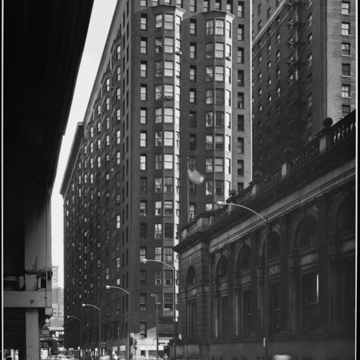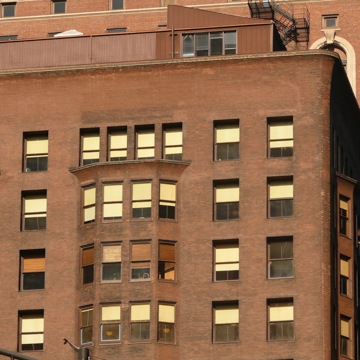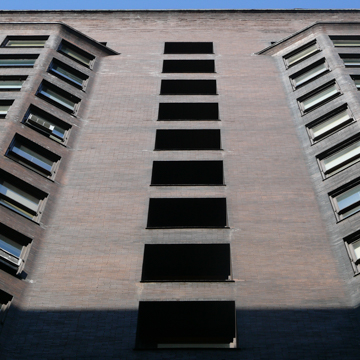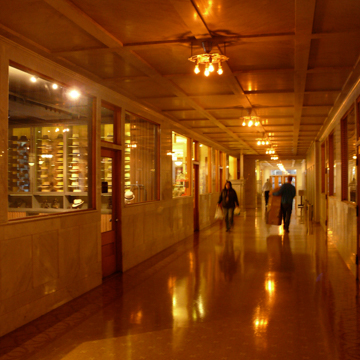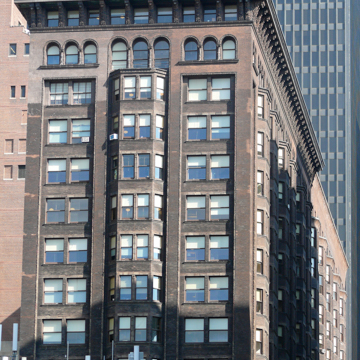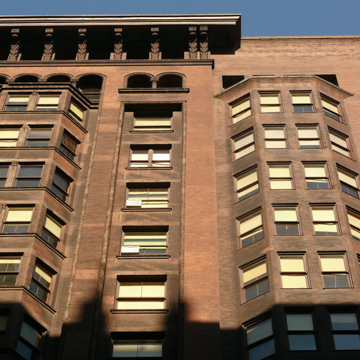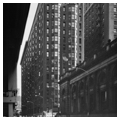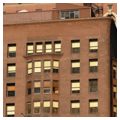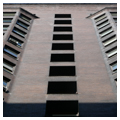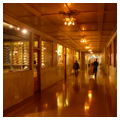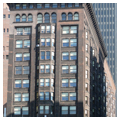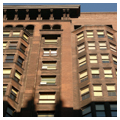You are here
Monadnock Building
The Mondanock Building, located on the south side of Chicago’s downtown, is a distinctively unified and simplified building, with smooth transitions from its ground-floor base all the way up to its curving cornice. Standing sixteen stories and 210 feet high, it is among the tallest load-bearing masonry structures in the world, and this engineering achievement is incorporated into a design of subtle sparseness, free of clearly identifiable style.
Burnham and Root designed the Monadnock near the end of a period of remarkable architectural innovation and productivity in Chicago—one that defined the form of the modern commercial office building. The pair met in 1872, while working for Carter, Drake and Wight, and opened their own firm the following year, hoping to capitalize on the ongoing reconstruction following the 1871 fire. The apprentice-trained Daniel Burnham helmed the business, while John Wellborn Root, with more formal architectural training, focused on design. After several years designing residences that built on Henry Hobson Richardson’s vision of sophisticated and eclectic revivalism, Burnham and Root were approached by Boston brothers Peter and Shepherd Brooks to design the ten-story Montauk Building (1882–1883, demolished 1902), initiating a decade of significant skyscraper design in the office. Just two years earlier, William LeBaron Jenney’s First Leiter Building (1879) had illustrated that benefits of incorporating iron elements into masonry structures, thus enabling wider windows and taller buildings, profitable attributes for commercial structures in dense urban districts. Burnham and Root built their practice designing multistory commercial buildings, with the masterful Rookery (1886), also commissioned by the Brooks brothers, marking the firm as masters of the new building type.
Burnham and Root began thinking about the site that would be occupied by the Monadnock Building sometime before 1885, when the Brooks brothers acquired the long narrow parcel on Jackson Boulevard between Dearborn and Federal streets, south of Chicago’s commercial core. Root took the lead as chief designer, and, mindful of the client’s repeated dictum to eschew unnecessary ornament, he proposed a scheme that was Egyptian Revival in style, with a main entry flanked by canted columns, as well as the base, shaft, and capital divisions common to contemporary skyscrapers. A unified outward curve at the cornice level, detailed to reference the lotus capital, was a distinctive departure from contemporary skyscraper designs. Though they had this initial design in hand, the Brooks brothers decided not to build for several years, hoping that downtown’s continued growth would increase interest in the location. For his part, Root continued reworking the design. Merging his client’s desire for simplicity with an empathy for pedestrians navigating the developing visual chaos of downtown Chicago, Root found expressive force in unadorned and muscular massing.
In 1889, more than four years after acquiring the site, the investors were ready to build. In his final scheme, Root transformed the overtly revivalist elements into what is best described as “Egyptoid” form; the battering of the wall above the base (notable especially at the chamfered corners) and the cavetto of the roofline termination evoking but not copying the temple architecture of Ancient Egypt. Rather than breaking up the building’s surface, Root focused on the nature of the envelope, selecting an unusual, dark, purple-brown masonry that, along with specially cast bricks that seamlessly turn corners, gives the appearance of a continuous skin.
Occupying the full width of the narrow block of West Jackson Boulevard between Plymouth and Dearborn, the two freestanding corners of the Monadnock are artfully curved and the energy of the building seems to rise along these curves to the smoothly rounded parapets. Six-foot thick walls support the building at the ground floor, standing on a raft of concrete and rails set into the boggy lakeshore soil. From the massive base, which is marked only by the deep-set, unframed window and door openings, the building curves gently inward. Thin sills protruding from each punched opening are in palpable tension with the taut envelope, emphasizing the skin-like nature of the facade. The quoined stone entry on the north, Jackson Street facade, with its sans serif name over the door, provides appropriately restrained elaboration at the main entry. At the third floor, three-sided oriel windows project smoothly forward and rise to the fifteenth floor. The cornice curves outward, mirroring the gesture between the base and shaft.
The Brooks brothers preferred the known durability of load-bearing masonry. Situated between downtown and the recently constructed Dearborn Station (1885), however, the desirable location encouraged the investors to build as high as possible, to 215 feet—an unprecedented height for load-bearing construction. Along with the nearby and nearly contemporaneous sixteen-story, iron-framed Manhattan Building (1889, William LeBaron Jenney), the Monadnock includes cast- and wrought-iron struts riveted between openings to provide wind bracing for the tower. Aided by digital reconstructions based on construction drawings, historian Thomas Leslie has studied Root’s extensive use of metal bracing in the Monadnock and concluded that the building is more properly understood as a structural hybrid rather than a pure masonry construction, notwithstanding the expressive power of its massive brick piers.
Built with an internal east-west party wall and originally named the Monadnock and Kearsarge Buildings (named after a pair of mountains in New Hampshire), the arrangement was intended to allow the brother investors to eventually split their property cleanly. Each building has its own entrance, and a single, double-loaded corridor passes through the center of the building, with mosaic tile floors, marble wainscot, and wood-framed glazed office storefronts lining the long north-south corridor.
Upon its 1891 opening, the massive Monadnock Building shifted the center of business in the city southward, and quickly proved an investment success. Accordingly, the Brooks brothers acquired the vacant southern section of the block, in anticipation of an addition. Root died in January 1891, however, during the construction of the Monadnock, and his untimely death redirected the focus of his firm. In 1892 the Brooks brothers hired the firm Holabird and Roche to design the addition. A more aesthetically conventional structure, the building, christened the Katahdin and the Wachusett (two other New England peaks), adopted the Monadnock’s distinctive brick color, floor heights, and multistory oriel windows, but features more traditional base-shaft-cap divisions and a heavy overhanging dentilated cornice. All four portions ultimately became known as the Monadnock, and remain in use as commercial office space.
Sympathetic renovations in 1938 and 1992 allowed the building to adapt to contemporary needs, while continuing to attest to Root’s vision of the Monadnock as a towering, unified element not only providing office space but also offering aesthetic respite to the weary passersby. An acclaimed restoration of the building was completed in 1987 by Vinci Hamp Architects, which included cleaning the surface brick to once again reveal the purple-brown brick of Root’s original vision.
References
Condit, Carl. The Chicago School of Architecture: A History of Commercial and Public Building in the Chicago Area 1875-1925. Chicago: University of Chicago Press, 1964.
Hines, Thomas S. “No Little Plans: The Achievement of Daniel Burnham.” Art Institute of Chicago Museum Studies 13:2 (1988): 96-105.
Hoffman, Donald The Architecture of John Wellborn Root. Chicago: University of Chicago Press, 1988.
Leslie, Thomas. “The Monadnock Building, Technically Reconsidered.” CTBUH Journal, Issue IV (2013): 26-31.
Merwood, Joanna. Chicago 1890: The Skyscraper and the Modern City. Chicago: University of Chicago Press, 2009.
O’Gorman, James. Three American Architects: Richardson, Sullivan and Wright. Chicago: University of Chicago Press, 1991.
Writing Credits
If SAH Archipedia has been useful to you, please consider supporting it.
SAH Archipedia tells the story of the United States through its buildings, landscapes, and cities. This freely available resource empowers the public with authoritative knowledge that deepens their understanding and appreciation of the built environment. But the Society of Architectural Historians, which created SAH Archipedia with University of Virginia Press, needs your support to maintain the high-caliber research, writing, photography, cartography, editing, design, and programming that make SAH Archipedia a trusted online resource available to all who value the history of place, heritage tourism, and learning.

